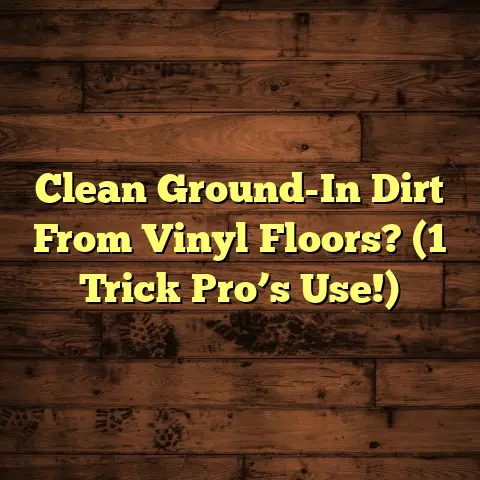Cheap Fake Wood Flooring: Worth It? (9 Risks!)
Let’s be honest, we’ve all been there. Staring at those outdated, worn-out floors, dreaming of a beautiful, new surface without breaking the bank.
Fake wood flooring, especially the cheaper stuff, can seem like a godsend. It promises the look of hardwood at a fraction of the cost, and the allure of a quick and easy DIY project is strong.
But before you rush out and load up your cart, let’s pump the brakes for a sec.
I’ve seen firsthand how these “budget-friendly” options can quickly turn into costly headaches. People are often searching for quick fixes, a band-aid solution to a bigger problem.
They want that instant gratification, that “wow” factor without the “ouch” of a hefty price tag.
But trust me, sometimes that instant gratification comes with a long-term price you might not be prepared to pay.
In this article, I’m going to break down the nine major risks you need to consider before opting for cheap fake wood flooring. We’ll dive deep, get technical, and use my years of experience to help you make an informed decision.
Ready? Let’s get started!
Section 1: Understanding Cheap Fake Wood Flooring
Okay, so what exactly is “cheap fake wood flooring?”
It’s a broad term that usually encompasses a few different types of materials designed to mimic the appearance of real hardwood.
Here’s a quick rundown:
-
Laminate Flooring: This is probably the most common type. It’s made of a composite wood base topped with a photographic layer that looks like wood and then covered with a clear, protective wear layer.
-
Vinyl Flooring (Luxury Vinyl Plank – LVP): Vinyl flooring comes in sheets, tiles, or planks. LVP is specifically designed to look like wood. It’s made of several layers of synthetic materials, including PVC and a wear layer.
-
Engineered Wood (Sometimes): Now, this one’s tricky. Good engineered wood is actually a great option. It has a thin layer of real hardwood on top of a plywood or fiberboard core.
However, cheap engineered wood might use a very thin veneer of low-quality wood or even a printed layer similar to laminate.
Materials Matter:
The key difference between these and real hardwood lies in the materials. Real hardwood is, well, real wood. It’s solid, durable, and has a natural grain and texture.
Fake wood flooring, on the other hand, relies on synthetic materials and printing technology to create the illusion of wood.
For example, a cheap laminate might use a lower density fiberboard (LDF) core, which is more susceptible to moisture damage than the high-density fiberboard (HDF) used in better quality laminates.
Cost Considerations:
The cost savings with fake wood flooring can be significant upfront. You might pay anywhere from \$2 to \$5 per square foot for cheap fake wood, while real hardwood can easily cost \$8 to \$15 or more.
Installation costs can also be lower, especially if you’re planning a DIY project.
However, remember that lower upfront costs don’t always translate to long-term savings. We’ll get into why in the following sections.
Section 2: Risk 1 – Durability Issues
This is where the rubber meets the road, folks. How long is this stuff really going to last?
Compared to real hardwood, cheap fake wood flooring often falls short in the durability department.
Here’s why:
-
Wear Layer Woes: The wear layer is the top, protective coating that determines how well your floor can withstand scratches, dents, and stains. Cheap flooring often has a thin or low-quality wear layer.
For example, a laminate floor with an AC (Abrasion Class) rating of 1 or 2 is only suitable for very light residential use, while an AC 4 or 5 is needed for high-traffic areas. Many cheap options skimp on this, leading to premature wear and tear.
-
Moisture Mayhem: Moisture is the enemy of many flooring types, but cheap fake wood is particularly vulnerable. LDF cores in laminate can swell and warp when exposed to water.
Vinyl is generally more water-resistant, but cheaper versions might have weak seams that allow moisture to seep underneath.
-
Foot Traffic Follies: High foot traffic can quickly take its toll on cheap flooring. The surface can scratch easily, and the edges can chip or peel.
Real-World Examples:
I’ve seen countless cases where homeowners opted for cheap laminate in their kitchens or bathrooms, only to have it buckle and warp within a year or two due to spills and humidity.
I recall a client of mine who installed cheap vinyl flooring in her hallway, and within months, the pattern was completely worn off in the high-traffic areas, leaving unsightly bald spots.
These are not isolated incidents. The truth is, cheap flooring simply isn’t built to withstand the rigors of everyday life.
Section 3: Risk 2 – Aesthetic Limitations
Okay, so maybe it looks good in the store. But how does cheap fake wood flooring hold up visually over time?
Here’s the deal:
-
Authenticity Absent: Let’s face it, nothing truly replicates the natural beauty and warmth of real wood. Cheap fake wood often looks, well, fake.
The printed patterns can be repetitive and lack the subtle variations and imperfections that make real wood so appealing.
-
Fading and Scratching: Over time, the colors in cheap fake wood can fade due to sunlight exposure. Scratches are also more noticeable because they reveal the underlying material, which is a different color than the surface pattern.
-
Texture Troubles: Real wood has a distinct texture that you can feel under your feet. Cheap fake wood often feels flat and artificial.
Some higher-quality options have embossed textures that mimic the grain of wood, but even these fall short of the real thing.
The Visual Difference:
Think of it like this: a high-resolution photograph of a painting is nice, but it’s not the same as seeing the original in person. The same principle applies to flooring.
Cheap fake wood might look acceptable from a distance, but up close, the flaws become more apparent.
Section 4: Risk 3 – Environmental Concerns
Now, let’s talk about something that’s becoming increasingly important: the environmental impact of our choices.
Cheap fake wood flooring often comes with some serious environmental baggage:
-
Manufacturing Mayhem: The production of synthetic flooring materials can be energy-intensive and generate significant pollution.
For example, PVC (polyvinyl chloride), a common ingredient in vinyl flooring, is made from petroleum and chlorine, both of which have environmental concerns associated with their extraction and processing.
-
Unsustainable Materials: Some cheap flooring options use materials that are not sustainably sourced. This can contribute to deforestation and habitat loss.
-
VOCs (Volatile Organic Compounds): Many synthetic flooring products release VOCs, which are chemicals that can evaporate into the air and cause health problems.
Formaldehyde, a common VOC found in some laminate flooring, is a known carcinogen. While regulations have reduced the levels of formaldehyde in flooring, cheap options might still contain higher concentrations.
Health Risks:
Exposure to VOCs can cause a range of symptoms, including headaches, dizziness, eye and throat irritation, and respiratory problems.
People with asthma or other respiratory conditions are particularly vulnerable.
Making Greener Choices:
If you’re concerned about the environment, look for flooring options that are certified by organizations like the Forest Stewardship Council (FSC) or Greenguard.
These certifications ensure that the products meet certain environmental and health standards.
Section 5: Risk 4 – Installation Challenges
So, you’ve got your cheap flooring, and you’re ready to install it yourself. What could go wrong?
Quite a bit, actually.
-
Subfloor Shenanigans: A proper subfloor is crucial for a successful flooring installation. If your subfloor is uneven, damaged, or not properly prepared, your new flooring will likely have problems.
Cheap flooring is often less forgiving of imperfections in the subfloor than real wood.
-
Fit Fumbles: Cheap flooring can be difficult to cut and install properly. The edges might not align perfectly, creating gaps and uneven seams.
-
Warping Woes: If the flooring is not acclimated to the room’s temperature and humidity before installation, it can warp or buckle after it’s installed.
DIY Disasters:
I’ve seen countless DIY flooring projects go wrong due to improper installation.
I remember one homeowner who installed cheap laminate flooring in his basement without properly sealing the concrete subfloor. The moisture from the concrete caused the laminate to swell and buckle within weeks.
Professional Power:
While DIY installation can save you money upfront, it can also lead to costly mistakes. Hiring a professional installer ensures that the job is done right the first time.
Section 6: Risk 5 – Maintenance and Repair Costs
Okay, so you’ve installed your cheap flooring. Now, how do you keep it looking good? And what happens when it gets damaged?
-
Maintenance Matters: Cheap fake wood flooring often requires more frequent and careful cleaning than real wood. You need to use specific cleaning products that won’t damage the surface.
Avoid harsh chemicals and abrasive cleaners, as these can scratch or dull the finish.
-
Repair Roadblocks: When cheap flooring gets damaged, repairs can be difficult and costly. Scratches and chips are often impossible to fix without replacing the entire plank or section of flooring.
-
Replacement Reality: If a section of flooring is badly damaged, you might have to replace the entire floor, especially if the original product is no longer available.
The Long-Term Cost:
While the initial cost of cheap flooring might be lower, the long-term maintenance and repair costs can quickly add up.
Real wood, on the other hand, can be refinished multiple times, extending its lifespan and saving you money in the long run.
Section 7: Risk 6 – Resale Value
Thinking of selling your home in the future? Your flooring choices can have a significant impact on its resale value.
-
Buyer Perceptions: Many homebuyers view cheap fake wood flooring as a sign of low quality. They might assume that the flooring will need to be replaced soon, which can lower their offer.
-
Market Trends: Real estate agents often advise sellers to invest in high-quality flooring to attract buyers. Hardwood floors are consistently ranked as one of the most desirable features in a home.
-
Return on Investment (ROI): While installing new flooring can increase your home’s value, the ROI on cheap flooring is often lower than on real wood.
Expert Opinions:
Real estate experts agree that flooring is one of the most important factors that buyers consider when evaluating a home.
According to a 2023 survey by the National Association of Realtors (NAR), 82% of buyers said that flooring was either “very important” or “important” in their decision-making process.
The Bottom Line:
If you’re planning to sell your home in the near future, investing in high-quality flooring can be a smart move. It can increase your home’s value and make it more attractive to buyers.
Section 8: Risk 7 – Sound and Comfort
Let’s talk about something you might not have considered: how your flooring affects the sound and comfort of your home.
-
Sound Sensitivity: Cheap fake wood flooring often transmits sound more easily than real wood. This can be a problem if you have kids, pets, or live in an apartment.
Footsteps, dropped objects, and other noises can be amplified, creating a noisy and uncomfortable environment.
-
Comfort Concerns: Real wood has a natural warmth and cushioning effect that makes it comfortable to walk on. Cheap fake wood often feels cold and hard underfoot.
This can be especially noticeable in the winter months.
-
Acoustic Afterthoughts: The acoustics of a room can also be affected by the type of flooring you choose. Cheap fake wood can create echoes and reverberations, making the room sound less pleasant.
Everyday Living:
Think about how you use your floors every day. Do you walk around barefoot? Do you have kids who play on the floor? Do you value peace and quiet?
If so, the sound and comfort of your flooring are important considerations.
Section 9: Risk 8 – Warranty and Lifespan
Let’s delve into warranties and lifespans—two critical factors when evaluating any flooring option.
-
Warranty Woes: Cheap fake wood flooring often comes with limited warranties that cover only manufacturing defects. These warranties typically don’t cover wear and tear, moisture damage, or improper installation.
-
Lifespan Limitations: The average lifespan of cheap fake wood flooring is significantly shorter than that of real wood.
Laminate flooring might last 5-10 years, while vinyl flooring might last 10-15 years. Real wood, on the other hand, can last for decades with proper care.
-
Long-Term Satisfaction: Consider what you want in the long run. Even though the warranty might sound good, how long will the floor last?
The Fine Print:
Always read the fine print of the warranty before you buy. Pay attention to what’s covered and what’s not.
Also, keep in mind that warranties are only as good as the company that stands behind them.
Section 10: Risk 9 – Installation Errors and Professional Help
Let’s discuss the critical importance of professional installation versus DIY efforts.
-
DIY Dangers: While DIY flooring installation can save you money upfront, it can also lead to costly mistakes.
Common DIY errors include improper subfloor preparation, incorrect cutting, and failure to leave expansion gaps.
-
Exacerbated Risks: Installation errors can exacerbate other risks associated with cheap flooring, such as moisture damage, warping, and premature wear.
-
Professional Precision: A professional installer has the knowledge, skills, and tools to ensure that the job is done right the first time.
Expert Advice:
I always recommend hiring a professional installer, especially if you’re not experienced with flooring installation.
A professional can properly prepare the subfloor, install the flooring correctly, and ensure that it looks and performs its best.
Conclusion
So, there you have it: nine major risks associated with cheap fake wood flooring.
While the allure of a quick and affordable flooring solution is understandable, the long-term consequences can outweigh the initial savings.
From durability issues and aesthetic limitations to environmental concerns and installation challenges, cheap flooring often comes with a hidden price tag.
Before you make a decision, weigh your options carefully. Consider not only the immediate cost but also the potential for future issues and expenses.
Think about your lifestyle, your budget, and your long-term goals.
And remember, sometimes the best investment is the one that lasts.





